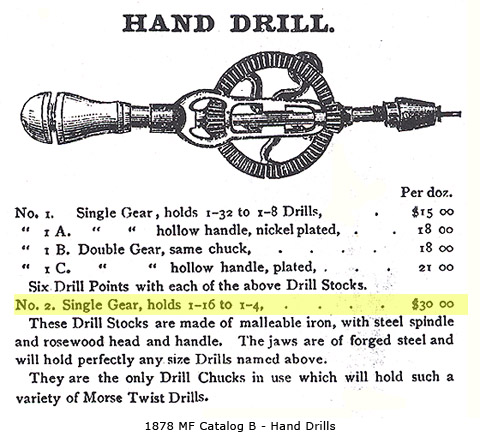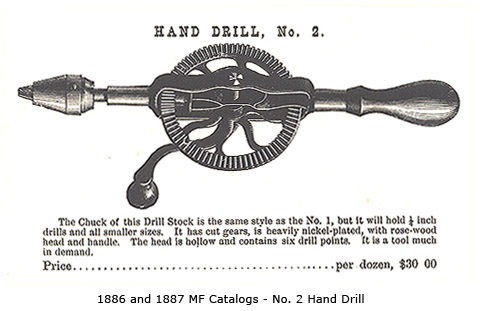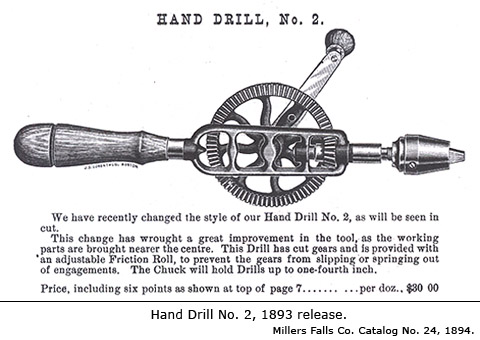
"No. 2. Single Gear, holds 1/16 to 1/4.
These Drill Stocks are made of
malleable iron, with steel spindle and rosewood head and
handle. The jaws are forged steel and will hold
perfectly any size Drills named above. They are
the only Drill Chucks in use which will hold such a
variety of Morse Twist Drills."
However, the drill described here is
nothing more than original drill No. 1 with a larger
chuck. Since there was no construction changes, it
is, in my view, more of a marketing gimmick rather than
a new design. Hence, taking this into account, I
will not consider it as a "real" No. 2 drill.
The "real" No. 2 drill appeared almost ten years
later. The work on new design begun sometime in the
mid-1880s. The earliest image of drastically
modified No. 2 Hand Drill is shown in catalogs dated
1886 and 1887.

"The Chuck of this Drill Stock is the
same style as the No. 1 but it will hold 1/4 inch drills
and all smaller sizes. It has cut gears, is
heavily nickel-plated, with rose-wood head and handle.
The head is hollow and contains six drill points.
It is a tool much in demand."
The description of chuck mentioned in both
catalogs refers to a chuck patented by
Henry L. Pratt in 1877. This chuck was used
on many early Millers Falls Hand Drills until it was replaced by
spring-less chuck, patented by William H. McCoy in 1896.
Here are a few points on dating. Consider
a hypothetical timeline for a tool shown in a catalog. First, drills had to be build,
tested and modified enough to arrive with final production
versions. After all that, I imagine, some presentations
had to take place with potential retailers, the terms of sales
negotiated and agreed upon. Then engravers needed to spend some
time to produce images. This material with final
descriptions of the drills would be incorporated
in a catalogs and forwarded to printers.
Considering this sketchy plan, the
drills most likely went into production well in advance of deadlines for printing.
The catalog dated 1886 was most likely available to the public
at the beginning of the year. This means that drill No. 2
shown in the catalog from 1886 was produced sometime during 1885
and the
prototype work might began as early as 1884. For the
purpose of reference, I will date this new No. 2 drill as a 1885
design.
In some contemporary writings
(print and Internet) the date stamped on the chuck is referred
to as a guidance for dating drill design. This is
obviously a nonsense.
Overall there were six major design changes in
the development of this drill - in 1885, 1893, 1895, 1903, 1938
and 1957. All other changes like handle variations,
improved chucks, etc. are rather minor. They do not
constitute construction change and are not a subject or this
overview.
Around 1893
company released a drill that completely departed from
the original frame design.

This release however did not have a side handle
and continued with a Pratt's two-jaws, spring-less chuck.
It also used elongated and slim main handle with a rounded cup.